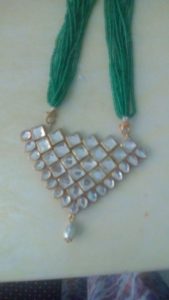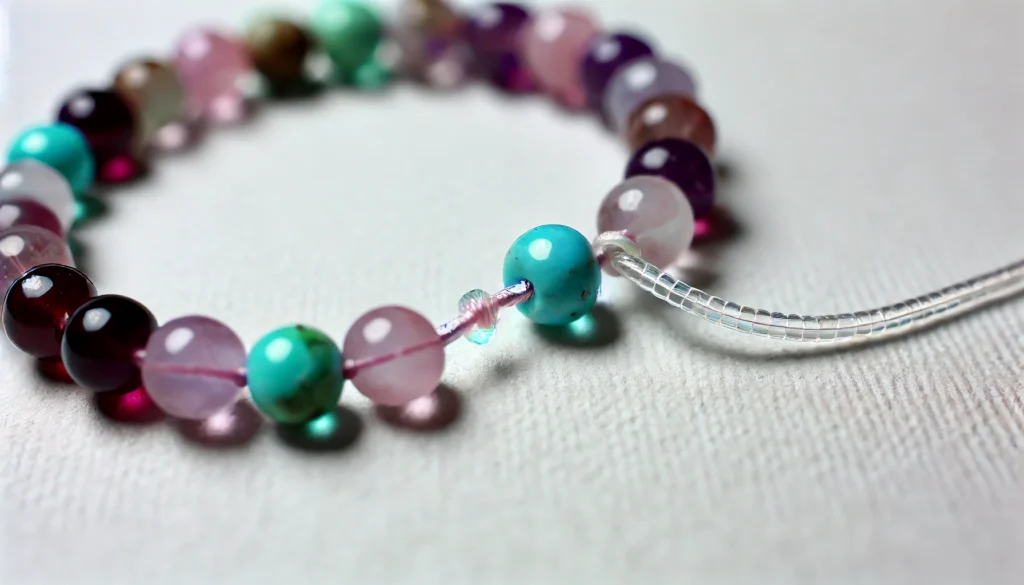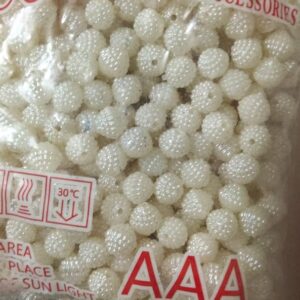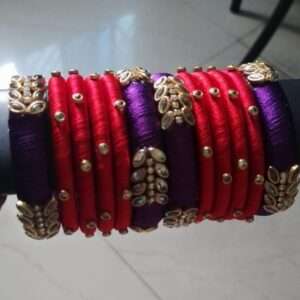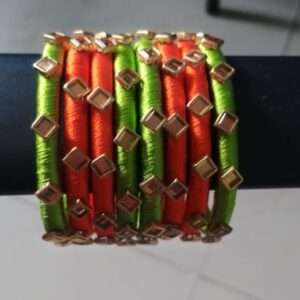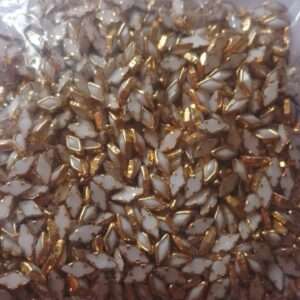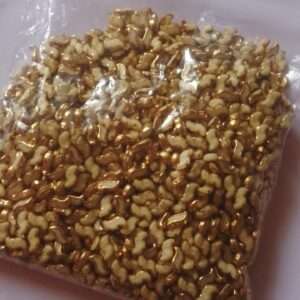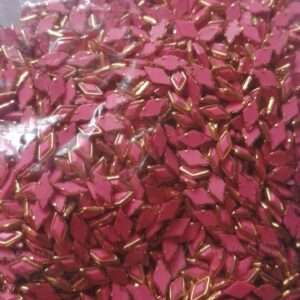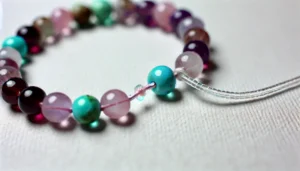Home » DIY Tutorials
Category Archives: DIY Tutorials
DIY Silk Thread Necklace: Step-by-Step Tutorial with Pictures
A silk thread necklace is an elegant and affordable alternative to gold or stone jewellery. Handmade silk thread necklaces are perfect for festive occasions, weddings, and ethnic outfits.
In this step-by-step guide, you’ll learn how to create a beautiful silk thread necklace using simple materials at home.
Why Make a Handmade Silk Thread Necklace?



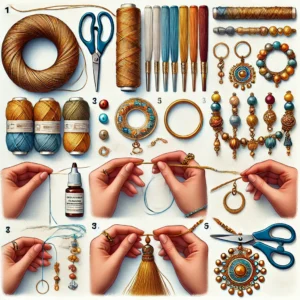
Materials Needed:
- Silk thread (colour of your choice)
- Necklace cord or thick wire (for the base)
- Threaded beads (gold, pearl, or coloured)
- Fabric glue or Fevicol
- Scissors
- Hook clasps (for securing the necklace)
Step-by-Step Process
Step 1: Prepare the Base
- Cut a necklace cord or thick wire to the desired length (15-18 inches).
- Apply a thin layer of glue and start wrapping silk thread tightly around the wire.
- Ensure the thread is evenly wrapped for a smooth look.
Step 2: String the Beads
- Once the thread wrapping is complete, start threading beads onto the necklace.
- Arrange them in a pattern (e.g., alternating colours or sizes).
- Add spacers or small pearls between large beads for a designer look.
Step 3: Securing the Ends
- Use hook clasps at both ends of the necklace to secure it.
- Apply glue inside the clasp area for extra durability.
- Allow it to dry completely for at least 4-5 hours before wearing.
Step 4: Final Touches & Wearing
- Check for any loose beads and secure them with extra glue if needed.
- Pair your handmade silk thread necklace with matching earrings or bangles for a complete look.
Expert Tips for a Professional Finish



How to make handmade silk thread jhumkas (earrings) – A beginner’s guide
Silk thread jhumkas are a timeless fashion accessory that complements both traditional and contemporary outfits. Making them at home allows you to experiment with colours, designs, and embellishments to match your style.
This step-by-step guide will walk you through making silk thread jhumkas using simple materials.
Why Make Your Own Silk Thread Jhumkas?



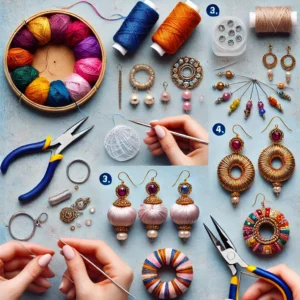
Materials Needed:
- Silk thread (any colour)
- Plastic or wooden jhumka base (available online or in craft stores)
- Fabric glue or Fevicol
- Earring hooks and headpins
- Scissors
- Decorative beads, stones, or gold chains
Step-by-Step Process
Step 1: Wrapping the Jhumka Base
- Take a plastic or wooden jhumka base.
- Apply a thin layer of fabric glue evenly across the base.
- Start wrapping silk thread tightly around the base.
- Ensure there are no gaps between the thread layers for a polished look.
Step 2: Attaching the Earring Hook
- Use a thin headpin to pierce through the top centre of the jhumka base.
- Slide a small bead onto the pin for extra decoration.
- Attach the earring hook by bending the headpin into a loop using pliers.
Step 3: Adding Decorative Elements
- Glue small beads, pearls, or golden chains around the jhumka’s edge.
- Use a toothpick to apply glue carefully for neatness.
- Arrange beads symmetrically for a professional finish.
Step 4: Let It Dry & Wear
- Allow the earrings to dry completely for at least 3-4 hours.
- Your beautiful handmade silk thread jhumkas are now ready to wear!
Expert Tips for Perfect Silk Thread Jhumkas



Step-by-Step guide to making silk thread bangles at home
Silk thread bangles are a beautiful and affordable alternative to traditional gold and glass bangles. Their vibrant colours and intricate designs make them a perfect accessory for ethnic and festive wear. In this guide, you’ll learn how to make silk thread bangles at home with simple materials and creative designs.
Why Choose Handmade Silk Thread Bangles?
- Budget-friendly – Costs much less than gold or metal bangles.
- Customisable – Choose colours, patterns, and decorations.
- Lightweight & Comfortable – No risk of breakage like glass bangles.
- Materials Needed:
- Plain plastic or metal bangles (any size)
- Silk thread in your preferred colours
- Fevicol or fabric glue
- Toothpicks or glue brush for even application
- Scissors
- Small decorative stones, beads, or pearls
Step-by-Step Process
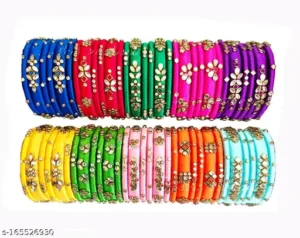
Step 1: Prepare the Bangle Base
- Choose a sturdy bangle (plastic or metal).
- If using multiple bangles together, stick them using strong glue and let them dry.
- Apply a thin layer of Fevicol or fabric glue in small sections for easy handling.
Step 2: Wrapping the Silk Thread
- Tie one end of the silk thread inside the bangle to secure it.
- Begin wrapping the silk thread tightly and evenly around the bangle.
- Use toothpicks to spread the glue as you wrap, ensuring a smooth finish.
Step 3: Securing the Ends
- Once fully wrapped, apply glue to the last part of the thread.
- Press it gently and hold for a few seconds to let it dry.
Step 4: Adding Decorations
- Use small beads, pearls, or decorative stones to embellish the bangle.
- Arrange them in patterns or as a single line for a designer look.
- Use a toothpick to apply glue and carefully place each stone.
Step 5: Let It Dry & Wear
- Allow the bangles to dry completely for a few hours before using them.
- Pair them with matching outfits for a stylish ethnic look.
Tips for Making Perfect Silk Thread Bangles
- Use double layers of thread for a richer, fuller look.
- Mix two colours for a dual-tone effect.
- Try zigzag wrapping for a unique design.
- Add hanging beads or charms for an exclusive touch.
How to make handmade rubber bands and scrunchies at home – Step-by-step guide with pictures
Making rubber bands or scrunchies at home is a fun and easy DIY project. Below is a detailed guide on how to make both, along with step-by-step instructions.
How to Make a Handmade Rubber Band
Materials Needed:
- Natural rubber sheets or silicone strips
- Scissors
- Ruler
- Super glue or rubber adhesive
- A marker
Step-by-Step Process:
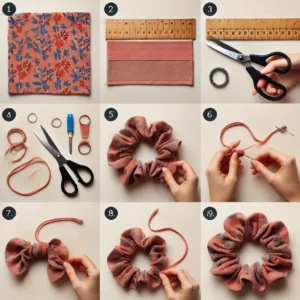
- Cut the Rubber Sheet:
- Use a ruler and marker to measure and draw thin strips (about 1 cm wide) on the rubber sheet.
- Cut along the lines using sharp scissors.
- Form the Band Shape:
- Take a rubber strip and stretch it slightly to check flexibility.
- Join the ends together to form a circle.
- Secure the Ends:
- Apply a small amount of rubber adhesive or super glue to the ends.
- Press the ends together firmly and let them dry for a few hours.
- Test the Elasticity:
- Once dry, stretch the band gently to check for strength and elasticity.
How to Make a Handmade Scrunchie
Materials Needed:
- A fabric of your choice (cotton, silk, or velvet)
- ¼ inch wide elastic (about 8-10 inches long)
- Sewing needle and thread or a sewing machine
- Scissors
- Safety pin
Step-by-Step Process:
- Cut the Fabric:
- Measure and cut a rectangular piece of fabric (around 20 inches long and 4 inches wide).
- Fold and Stitch the Fabric:
- Fold the fabric lengthwise, with the right sides facing each other.
- Sew along the long edge to create a fabric tube, leaving the ends open.
- Turn the Fabric Right-Side Out:
- Use a safety pin to help turn the fabric inside out.
- Insert the Elastic:
- Attach a safety pin to one end of the elastic and thread it through the fabric tube.
- Hold the other end to prevent it from getting lost inside.
- Secure the Elastic:
- Once the elastic is fully threaded, tie or sew the ends together securely.
- Close the Scrunchie:
- Tuck one end of the fabric into the other and sew it shut.
Your handmade scrunchie is now ready!
Delay in Deliveries & Pickups in Mumbai, Gujarat, and Noida Due to Heavy Rains
- Wani
- Bhadrawati
- Warora
- Gondpipari
- Gadchandur
- Aheri
- Sironcha
- Chamurshi
- Garhchiroli
- Surat
- Rajkot
- Jamshedpur
- Vadodra
- Noida
COVID-19 Update: Weekend Shutdown in 10 Districts of Odisha
- GANJAM
- MAYURBHANJ
- KHORDA
- BALASORE
- CUTTACK
- KENDRAPADA
- JAJPUR
- JAGATSINGHPUR
- JHARSUGUDA
- GAJAPATI
DIY box with a cardboard base and empty thread spools
As many of you are crafters, you will be having a lot of empty thread spools in your home. I made my kids to try to make a box with those empty threads and a cardboard base.
Below is the video of them making a box with empty thread spools and cardboard box.
To make it you require a card board base (I used a puzzle cardboard as they are not using it as they have grown up and empty thread spools. Fevicol to fix them on the base. You can also use a thick sheet of cardboard boxes.
Apply fevicol all over the sides and put empty thread spools on the fevicol. Your box will be ready soon. Allow it to dry for atleast 3 hours for better sticking.
Later you can paste a gliiter foam sheet or normal foam sheet or even colour or design paper for better looks. And can decorate the sidewalls as you wish.
Try it by your kids so that they will learn to make things out of waste. Comment your outcome below and can send pictures to pallavi.rags@gmail.com so that you can see your crafts in the website below in this post.
Kids School Projects – English – Homophones
What are Homophones?
Homophones are the two or more different words with same pronunciation with different meanings.
Examples of homophones:

Below is the list of homophones and above is the five sets of homophones done for a school project
- one-won
- see-sea
- meat-meet
- ear-year
- write-right
- weather-whether
- two-to
- here-hear
- ways-vase
- cot-caught
- sun-son
- hole-whole
- six-sikhs
- week-weak
- blue-blew
- sell-cell
- no-know
- hour-our
- ad-add
- ate-eight
- die-dye
- by-buy
- none-nun
- peace-piece
- sum-some
- wait-weight
- break-brake
- flour-flower
- steel-steal
Hope you got the list of easy homophones with known meaning. Comment if you know more homophones and we will add them to the list.
How to make pendant with framed kundans
Let us see how to make a pendant with kundan stones (framed Kundans) in this post. Or buy this pendant @ Rs 50 if you don’t have time to make it.
Materials required to make a kundan pendant:
- Square framed kundans – 8mm
- Thilak shape kundans – 8mm
- Canvas Sheet
- Gold colour/gold nail polish
- Drop shape pearl hanging
- Fevicryl
- Cutter
- Plier
- Eye Pins
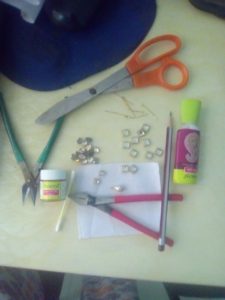
Step 1.
Take a canvas sheet and apply gold paint/nail polish on the canvas sheet using a paint brush or an ear bud. Allow it to dry.
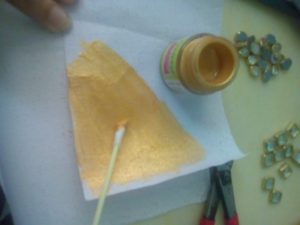
Step 2.
Put square shape kundans in a row on the dried gold colour canvas sheet.
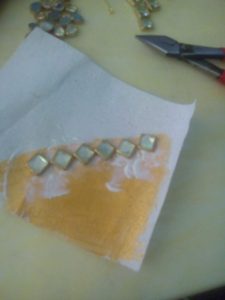
Next add another row of square kundans in between the top 2 kundans. It comes as 6 kundans in top row, 5 kundans in next row and finally to single kundan. Start from the top and add thilak shape kundans as shown in the picture below, only the centre thilak shape kundan points top wards.
Cut the canvas sheet from the remaining sheet as per the pendant shape. I used diy cutter to cut in between kundans.
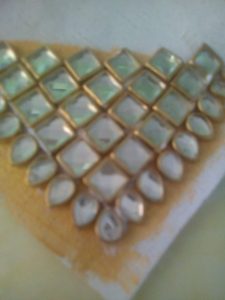
Allow them to dry or they will fell off the canvas sheet. Glue them well.
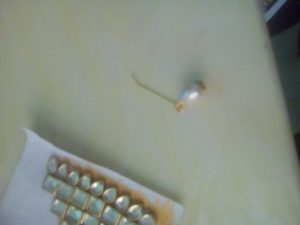
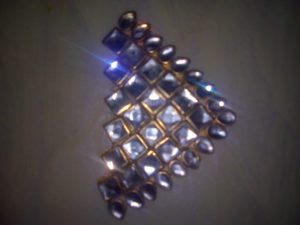
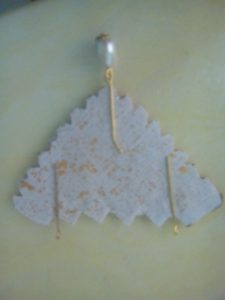
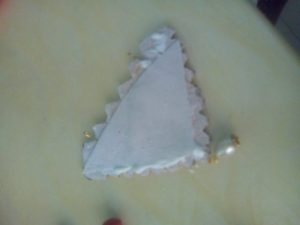
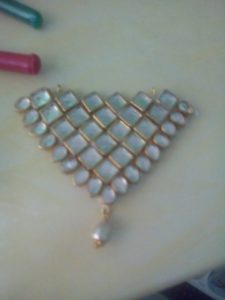
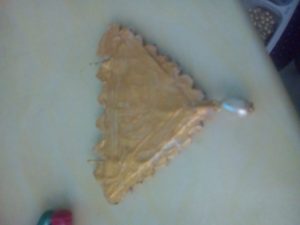
After it dries, turn it to other side and take a pearl hanging and attach it to an eye pin and keep at the downside of the pendant. Put two eyepins on the top at two gaps between kundans . Apply glue on the back side and put another canvas sheet to cover the eye pins and to secure them well. You can add two canvas sheets for strength and hardness of the pendant.
After that you can apply gold paint on the back side as well for neat finish.
Finally attach the well dried pendant to any chain and is ready to wear. I attached a ready made chain to the pendant and it looks like this.
